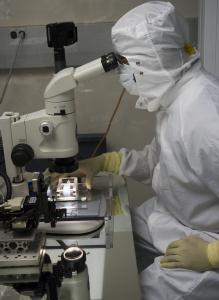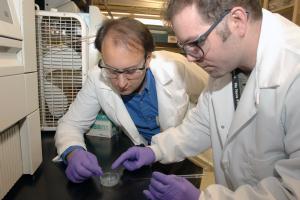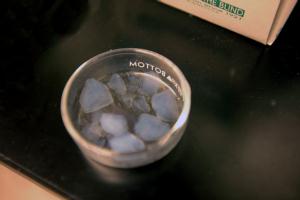Comets As Toolkits For Jump-Starting Life

A researcher examining a
Stardust aerogel tile under a stereo microscope.
|
December 14, 2006
Just as kits of little plastic bricks can be used to make everything from models of
the space shuttle to the statue of liberty, comets are looking more and more like
one of nature's toolkits for creating life. These chunks of ice and dust wandering
our solar system appear to be filled with organic molecules that are the building
blocks of life.
The discovery of two kinds of nitrogen-rich organic molecules in comet Wild 2 is
the latest addition to the set of bits and pieces useful to the origin of life that has
been found in comets.
These discoveries were made by members of the Stardust Preliminary
Examination Team, a group of scientists who have been studying the samples
returned from comet Wild 2 by NASA's Stardust spacecraft in January 2006.
"These results show that comets could have delivered nitrogen rich organic
compounds to the early Earth where they would have been available for the
origin of life," said Scott Sandford of NASA's Ames Research Center, Moffett
Field, Calif.
"This discovery shows that the menu of compounds available for the origin of life
was richer than had been previously thought," said Jason Dworkin of NASA's
Goddard Space Flight Center, Greenbelt, Md.
"The two molecules we discovered in comet Wild 2, methylamine and
ethylamine, provide a source of fixed nitrogen, a commodity which could have
been rare on the ancient Earth. Nitrogen fixation is the conversion of the very
stable nitrogen (N2) gas in our atmosphere to a biologically usable form, like an
amine or nitrate -- the same compounds found in fertilizer. Enzymes that fix
nitrogen appear to be ancient, so finding a source of fixed nitrogen would have
been an early challenge for life from the time of its origin. We determined that at
least one type of comet would have provided significant quantities of stable, fixed
nitrogen in the form of methylamine and ethylamine," added Dworkin.

NASA Goddard researchers Jason Dworkin (left) and Daniel Glavin (right) examine aerogel from the Stardust mission.
|
This is the first time these molecules have been detected in comets. As the
Stardust spacecraft sped through the comet's tail at nearly 21,000 kilometers per
hour (13,000 miles per hour), a set of aerogel tiles mounted on a boom trapped
dust and gas from the comet. Often referred to as "frozen smoke," aerogel is the
world's lowest density solid. Its low density allows it to slow and capture comet
dust particles without vaporizing them.
Although the mission's goal was to return samples of comet dust to Earth, the
researchers looked for organic molecules that were embedded in the aerogel
itself, rather than trapped in dust grains. "We found that the aerogel acted like a
sponge, absorbing organic gases from the comet nucleus," said Daniel Glavin of
NASA Goddard.
"And just like squeezing a sponge, we squeezed out all the good stuff -- the
water-soluble organics -- by boiling samples of the aerogel in ultra-high purity
water," added Glavin. The team analyzed the aerogel water extract with a liquid
chromatograph mass spectrometer instrument to identify the organic molecules.
Since Earth is crawling with life, the team had to rule out contamination from our
planet before it could say the molecules likely came from the comet. Glavin and
Dworkin analyzed dozens of "pre-flight" aerogels that were not flown on Stardust
in order to understand the organic background levels within the aerogel.

A close-up view of Stardust aerogel.
|
The team found high levels of both methylamine and ethylamine in aerogel that
was exposed to comet Wild 2. While they did find small amounts of methylamine
and trace levels of ethylamine in the pre-flight aerogel, the total amount in the
unflown aerogel was over 100 times less. Also, the relative amounts of the two
molecules were very different from that found in the comet-exposed aerogel. The
different total and relative amounts convinced the team that most of the two
chemicals in the Stardust sample came from the comet.
However, since Stardust was in space for seven years, the team had to be sure
that the two chemicals weren't simply picked up while the spacecraft was cruising
toward Wild 2. Since the pressure in space is so low, the spacecraft can release
gas or volatile materials acquired during its manufacture on Earth. This is called
"outgassing," and it could have contaminated the aerogel as well.
To reveal the levels of contamination from these two sources, the Stardust team
included a special piece of aerogel called the "witness tile" on the spacecraft. It's
a piece of aerogel located behind a dust shield that protected the spacecraft from
high-speed collisions with comet particles. This location kept the witness tile from
being exposed to gas and dust from the comet. But the witness aerogel was
exposed to everything else Stardust encountered, including the manufacturing
processes, shipping, the launch, spacecraft outgassing, and Earth reentry.
"When we analyzed a sample of the witness tile, we did not detect methylamine
or ethylamine, so we don't think Stardust was contaminated with these two
chemicals on the way to Wild 2," said Glavin.
NASA's Jet Propulsion Laboratory, Pasadena, Calif., manages the Stardust
mission for NASA's Science Mission Directorate, Washington. Dr. Peter Tsou of
JPL is deputy principal investigator and is a co-author on seven papers about the
mission's initial findings appearing in the Dec. 15 issue of Science Express, the
online edition of the journal Science.
For more information about Stardust studies and other mission information, visit:
http://stardust.jpl.nasa.gov/ .
JPL Media Contact for Stardust:
DC Agle
Phone: 818-393-9011
agle@jpl.nasa.gov
Last Updated: December 14, 2006
|
